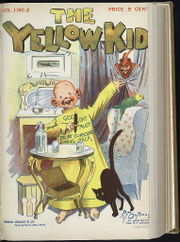
The artist's inspiration came from the tenement children running around in New York City, wearing hand-me-downs too large for them, and having shaved heads due to lice. He felt they always appeared happy, despite their dingy surroundings.

San Francisco Academy of Comic Art Collection, The Ohio State Univeristy Cartoon Research Library
Still, in the beginning, The Yellow Kid was more in line with what we would consider a political cartoon, rather than just slapstick humor or a story line comic.
Only a few decades later, newspapers would be filled with strips such as Gasoline Alley, Blondie, and Alley Oop; they all followed a basic format consisting of black and white characters in a rectangular strip. In 1914, Krazy Kat burst onto the scene with interesting background art, and an unconventional format.

Though others would also experiment with formatting within the limitations of the physical page, none would accomplish this lofty artistic goal quite as well as Bill Watterson's Calvin and Hobbes.

The comics in watercolors.
I'll say it now: If you don't like Calvin and Hobbes, you're a communist.

This isn't funny? Then the terrorists have already won.
When Calvin and Hobbes strips stopped, most people were bereft of any decent comics to read. This would continue for several years... until Al Gore invented the interwebs and we got webcomics.
No longer could the Evil Mass Media dictate what I could read and find amusing. Thousands of artists post their work (for better or for worse - joke intended) for us to enjoy/mock. The artistic limitations of printed press are discarded, for the most part.
We have swearing, nudity, 3-d characters, larger sizes, more colors, legos, horrible art/spectacular art, etc.

Well, I think it's funny.
Some of my favorites are Least I Could Do & Looking For Group, Something Positive, Girls with Slingshots, Gunnerkrigg Court, Phoenix Requiem, Abominable Charles Christopher (such good art!) and Goblins. Most of my favorites tell stories, but I don't complain when the gag-a-day strips are clever.

There are some negative aspects to webcomics, such as the lack of deadlines and the artists' sometimes feeble attempts to involve the audience in their own drama. I really get irritated when a Monday-Wednesday-Friday strip fails to update for a week, then the artist posts something enigmatic and lame such as, " OMG I've had so much personal stuff that I didn't have time to post."

Sure, I don't mind that excuse the first few times, but is your life really so much more complicated than everyone else's that you get to slack off?
Then they ask for donations. I'll donate if you're on time, not if we're all getting frustrated waiting for you to do your job (yes, webcomics are the full-time job for many of the artists - not all, but many).
Mostly, though, webcomics are an improvement.

Sometimes I wonder what those imaginative cartoonists of old would have done if they'd had the freedom of the internet.
*Applause*
ReplyDeleteDigestible pop culture in panels. Nice.
ReplyDeleteDefinitely an improvement. The newspapers heavily censored their comics for years. Have you ever read that Peanuts story arc where Lucy gets an abortion for Schroeder?
ReplyDeleteThanks for always bring much needed perspective to my little blog. ;)
ReplyDelete